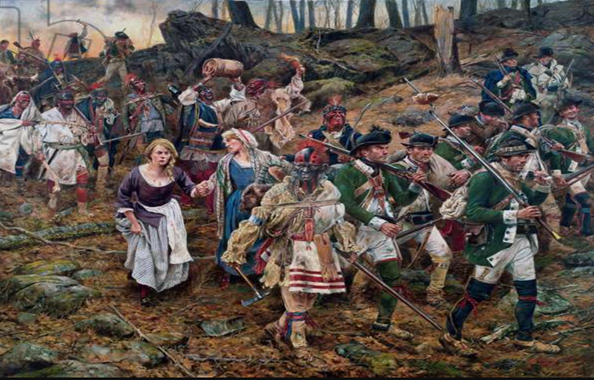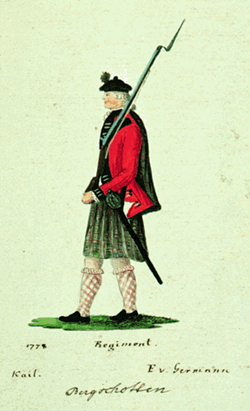During the war the German Flatts settlements took in the modern Frankfort, Illion and Herkimer NY area. The combined Loyalist/Indian force that destroyed the settlements in September of 1778 launched their raid from Oquaga (modern Windsor, NY). A large number of Indian department rangers made up the attacking force, and Oquaga sat nearby Unadilla. There is more than just the closeness of the two villages, however, to suggest that Wall took part in this raid. On September 21, Writing to Col. John Butler, the commander of the force, Capt. William Caldwell reported: “We returned to this place (Unadilla) yesterday morning after destroying all the buildings and grain at the German Flatts...Mr. Wall enquired particularly about your family but could learn nothing but that Mrs. Butler had been seen about 3 months ago at Schenectady.” This statement tells us that whether Wall was interrogating prisoners, or talking to remaining Loyalist sympathizers in the area, he had accompanied the raiding party that destroyed the German Flatts area. As his home, business and life before the war was located there, one cannot help but wonder if Wall had any conflicted thoughts as he helped to destroy the homes and livelihoods of his former friends, business associates and customers. Did he dwell on the irony of helping to destroy the very place he had helped to prosper before the war? Or, remembering the hypocritical actions of some of the committee of safety members, did he feel those rebelling against their lawful king and government were simply getting the punishment they deserved? We are left only with speculation.

It was well known to the rebels that both Unadilla and Oquaga were being used to launch many of the raids that had devastated the New York And Pennsylvania frontiers throughout 1778. In early October, a mixed force of Continental soldiers and local militia left their postings in the Schoharie Valley and destroyed both villages. Such was the spiteful nature of this civil war. The brutality brought against one side would eventually be repaid with the same or even greater brutality by the other.
It is at this point that Edward Wall once again does his familiar “disappearing act”. As both Unadilla and Oquaga were abandoned ahead of the rebel attacks, we know Wall made it safely away. Of his further service with the Indian department or other organizations he might have served with for the remainder of 1778 through June of 1780, we presently have no information.
It is in a muster roll covering the period of June 1780 through April of 1781, that Wall finally reappears. He is listed as a private in the Major’s Company of the 1st Battalion of the 84th Royal Highland Regiment in Canada, Unlike his service in the Royal Yorkers, however, we have nothing that gives us a clue as to whether he was once again a “Gentleman Volunteer”, hoping to eventually fill an officer’s commission, or he was serving full time in the ranks.
The “Royal Highland Emigrants” was initially a Loyalist Regiment raised by Scottish officer Lieutenant Colonel Allan MacLean. His plan was to recruit heavily from Scottish veterans settled in Canada after the French and Indian War, and from other highland immigrants in the 13 Colonies. The war broke out as Maclean started his recruiting, but he was able to muster enough men to aid in the defense of Quebec against the rebel invasion of Canada in 1775. The regiment then made up part of the British forces that drove the rebels out of Canada in the summer of 1776. In 1779, the regiment was placed on the regular British army establishment, and was numbered the 84th Regiment, although the” Royal Highland Emigrants” title continued to stick with it as well. Unlike the other highland regiments in the British Army that no longer wore their kilts, plaids, and highland weapons on active service, it is believed that the 84th regiment continued to dress and arm itself in the traditional highland fashion for much of the war.
June most likely brought about a happy reunion for Wall and his wife Deborah aswell. Colonel John Butler’s son Walter began a correspondence with rebel authorities in 1779, offering to trade the wife and children of Colonel Samuel Campbell, who had been captured during the raid on Cherry Valley, for the Butler family. Along with his mother, sisters and brothers, Walter lists “Mrs. Wall” as a family member, his cousin, Deborah Butler-Wall. The actual exchange process finally began in February of 1780, when the Governor-General of Canada, Fredrick Haldimand, wrote to the Butlers, stating that “A Flag shall be sent in the course of a few days, requiring that Mrs. Butler and family be sent into this Province in exchange for Mr. Campbell’s family rescued from the Indians for that purpose.” It would not be until June of that year, however, that the exchange would finally take place in Montreal. We can assume that Deborah Wall was part of that exchange. This would be the first time that Edward and Deborah had seen each other since sometime in 1775 or 1776.
Image below: A soldier of the 84th Regiment, circa 1778.

Along with doing extensive garrison and guard duty at various posts throughout Canada, detachments of the 1st Battalion, 84th Regiment took part in the British raids into the lower Champlain Valley and Lake George area in October of 1780 and the central Mohawk Valley area in November of 1781. The 1781 raid led to the Battle of Johnstown and the skirmish at West Canada Creek as the raiders retreated towards Canada. At the West Canada Creek skirmish, Wall’s cousin in law, Capt. Walter Butler, was killed. It is unknown at this time whether Wall’s company took part in any of these raids and battles. Whether he was present or not, it is tempting to speculate on what Wall’s feelings might have been as the war neared its end. He had lost former friends and business associates from the rebel side at the Battle of Oriskany, and an in-law on the Loyalist side at West Canada Creek. He had also participated in the destruction of at least one settlement in the Mohawk Valley, his former residence of German Flatts.
With the end of the war, the1st Battalion of the 84th Regiment was given land in “Upper Canada” (modern Ontario Province). Here, Wall leaves us to wonder if he had a “falling out” of some sort with his Butler in-laws. John Butler settled in and helped to found, the modern Niagara-on-the- Lake area. Edward and Deborah settled in the modern Gaspe area, on the eastern tip of Quebec Province, about as far away from his in-laws as he could possibly get. For whatever reason, however, Wall does one final bit of wandering, and finally ends up somewhere in Upper Canada. Here, Wall disappears from history for the final time. On the Home District Rolls for Upper Canada, Edward Wall is listed as deceased, sometime between 1796 and 1803.
So here ends the very incomplete and sketchy history of Edward Wall. A life that admittedly leaves us asking more questions concerning his motivations and actions during the Revolutionary War period than it answers. Not being one of “the great men of the Revolution”, however, Wall is also a person that many of us today can relate to. He is simply a person trying to make his way in the world and live his life to the best of his ability. He stays true to what he believes is best for him, his family and his country, while dealing with situations that often turned his life upside down.
SOURCES:
- Edward Wall, A Loyalist in Conflict- Article by Peter C. Betz, in “The Loyalist Gazette”, 1998.
- The History and Master Roll of The King’s Royal Regiment of New York- Brigadier General Ernest A. Cruikshank and Gavin K. Watt
- The British Campaign of 1777-The St. Leger Expedition- Gavin K. Watt
